The Qur˒an, the Holy Book of Islam
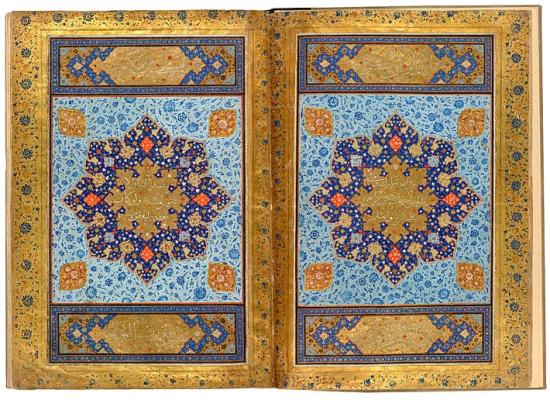
The Jerrāḥ Pasha Qur˒an
Qur˒an, in Arabic.
Purchased by Pierpont Morgan, before 1913
This gigantic Qur˒an (19 x 13 1/2 inches) was made in Shiraz about 1580. In 1719–20 it was given by Sultan Aḥmad III to the mosque of Jerrāḥ Pasha in Dikili Tash in Istanbul. The opening pages express the majesty and magnificence of the Qur˒an. Within the facing sunbursts are inscribed the words from sura 17.88: God, blessed and exalted is he, said, say, if mankind and the jinn collaborated to produce the likes of this Qur˒an, they will not produce its like even if they assist one another. The jinn were pre-Adam angels cast down with Iblīs (Satan). Within the four cartouches are the words from sura 56.77–9: It is the noble Qur˒an, in a Book well guarded, which none shall touch but those who are clean.
The Qur˒an, the Holy Book of Islam
From a monumental volume used in an Istanbul mosque to a miniature Persian version that served as a talisman, this section features examples of illuminated pages from the holy book of Islam. The Qur˒an (to recite) represents the codification of the words of God that were revealed and transmitted through the angel Gabriel to the prophet Muḥammad (ca. 570–632) over a period of twenty-three years. The visions began in 610 in a cave on Mount Hira near Mecca, his birthplace, and continued after his 622 flight to Medina, until his death. His flight—the Hijra—marks the beginning of the Islamic calendar.
The revelations were arranged into 114 suras (chapters), each named after its theme. The first and shortest ones, at the end of the book, from the Meccan period, establish Muḥammad as the final prophet in a line of monotheists, including Abraham and Jesus. The longest suras, placed at the beginning, are Medinan and deal more with social and political issues.
For centuries, Qur˒ans were written in Arabic, the language of transmission. After Muḥammad's death, his cousin ˓Alī and others compiled the revelations into a text. About twenty years later, under Uthman, the third caliph (644–656) succeeding Muḥammad, a standard version of the Qur˒an —essentially the one used today—was produced. Thereafter Islam (which means "surrender to God") spread from the Arabian Peninsula throughout the Middle East, to northern Africa and southern Spain, and eventually the world.
Jerrāḥ Pasha Qur˒an fols. 2v–3r
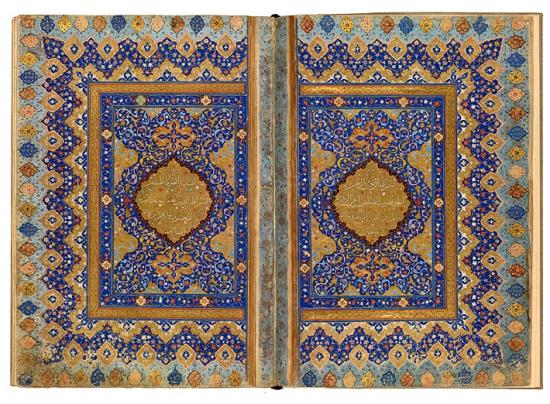
The First Sura of the Jerrāḥ Pasha Qur˒an
Qur˒an, in Arabic
Purchased by Pierpont Morgan, before 1913
This is the second pair of richly decorated facing pages in the Jerrāḥ Pasha Qur˒an, made in Shiraz about 1580. It marks the beginning of the Qur˒an itself, starting with sura 1 (al-Fātiḥa, or "The Opening Chapter"). The five lines of text on each page are enclosed within a gold-lobed medallion. They are written in raiḥān (sweet basil) script, which was much favored by poets, for its very name evoked its fragrance. Muḥammad Aṣlaḥ, an eighteenth-century poet, even wrote that real gardens would envy the raiḥān twig "lifting its head from the bismillah (call to piety)." The first line contains the title of the sura, followed by the call to piety, the bismillah: In the name of God, the Merciful, the Compassionate. The sura is continued on the left page. Each sura (except the ninth) begins with the bismillah. This double-opening, and the three others in the manuscript, closely resemble the work of the Ottoman master gilder Muḥammad ibn Tāj al-Dīn Ḥaidar (d. 1588).
The Qur˒an, the Holy Book of Islam
From a monumental volume used in an Istanbul mosque to a miniature Persian version that served as a talisman, this section features examples of illuminated pages from the holy book of Islam. The Qur˒an (to recite) represents the codification of the words of God that were revealed and transmitted through the angel Gabriel to the prophet Muḥammad (ca. 570–632) over a period of twenty-three years. The visions began in 610 in a cave on Mount Hira near Mecca, his birthplace, and continued after his 622 flight to Medina, until his death. His flight—the Hijra—marks the beginning of the Islamic calendar.
The revelations were arranged into 114 suras (chapters), each named after its theme. The first and shortest ones, at the end of the book, from the Meccan period, establish Muḥammad as the final prophet in a line of monotheists, including Abraham and Jesus. The longest suras, placed at the beginning, are Medinan and deal more with social and political issues.
For centuries, Qur˒ans were written in Arabic, the language of transmission. After Muḥammad's death, his cousin ˓Alī and others compiled the revelations into a text. About twenty years later, under Uthman, the third caliph (644–656) succeeding Muḥammad, a standard version of the Qur˒an —essentially the one used today—was produced. Thereafter Islam (which means "surrender to God") spread from the Arabian Peninsula throughout the Middle East, to northern Africa and southern Spain, and eventually the world.
Jerrāḥ Pasha Qur˒an fols. 274v–275r
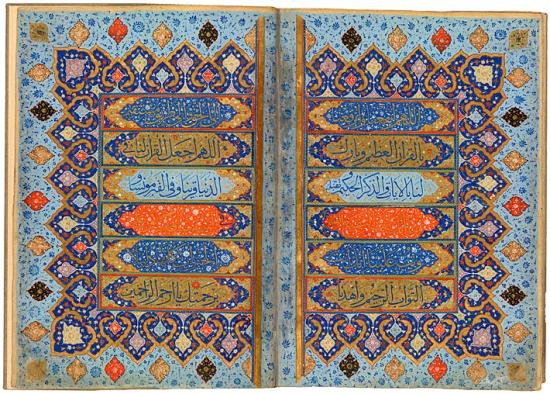
Closing Prayer in the Jerrāḥ Pasha Qur˒an
Qur˒an, in Arabic
Purchased by Pierpont Morgan, before 1913
This is the first of two pairs of elaborately ornamental facing pages that appear at the end of the Jerrāḥ Pasha Qur˒an, made in Shiraz about 1580. It enshrines a prayer written in twelve lines: Oh God, profit us and raise us through the magnificent Qur˒an, and bless us and accept the verses [we read] and the wise repetition [we make]... Turn toward us, for You are the Merciful One Who accepts the penitent, and guide us to the truth and to a straight path. Oh God, make for us the Qur˒an a constant companion in this world, a consoler to the grave, and... a guide for all good works, through Your mercy, oh Most Merciful.
The Qur˒an, the Holy Book of Islam
From a monumental volume used in an Istanbul mosque to a miniature Persian version that served as a talisman, this section features examples of illuminated pages from the holy book of Islam. The Qur˒an (to recite) represents the codification of the words of God that were revealed and transmitted through the angel Gabriel to the prophet Muḥammad (ca. 570–632) over a period of twenty-three years. The visions began in 610 in a cave on Mount Hira near Mecca, his birthplace, and continued after his 622 flight to Medina, until his death. His flight—the Hijra—marks the beginning of the Islamic calendar.
The revelations were arranged into 114 suras (chapters), each named after its theme. The first and shortest ones, at the end of the book, from the Meccan period, establish Muḥammad as the final prophet in a line of monotheists, including Abraham and Jesus. The longest suras, placed at the beginning, are Medinan and deal more with social and political issues.
For centuries, Qur˒ans were written in Arabic, the language of transmission. After Muḥammad's death, his cousin ˓Alī and others compiled the revelations into a text. About twenty years later, under Uthman, the third caliph (644–656) succeeding Muḥammad, a standard version of the Qur˒an —essentially the one used today—was produced. Thereafter Islam (which means "surrender to God") spread from the Arabian Peninsula throughout the Middle East, to northern Africa and southern Spain, and eventually the world.
Jerrāḥ Pasha Qur˒an fols. 275v–276r
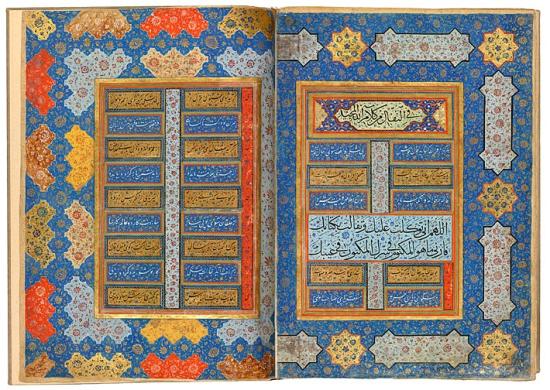
Auguries from the Jerrāḥ Pasha Qur˒an
Qur˒an, in Arabic
Purchased by Pierpont Morgan, before 1913
The second pair of decorated facing pages at the end of the Jerrāḥ Pasha Qur˒an contains texts relating to the taking of auguries from the Qur˒an, with an interpretation for each letter of the alphabet. There is a break in the sequence, indicating a missing folio. The headings are in muḥaqqaq script and the lines of poetry are in nasta˓līq script. According to tradition, muḥaqqaq, meaning "accurate", or "well-organized," was the first script to be regularized.
The Qur˒an, the Holy Book of Islam
From a monumental volume used in an Istanbul mosque to a miniature Persian version that served as a talisman, this section features examples of illuminated pages from the holy book of Islam. The Qur˒an (to recite) represents the codification of the words of God that were revealed and transmitted through the angel Gabriel to the prophet Muḥammad (ca. 570–632) over a period of twenty-three years. The visions began in 610 in a cave on Mount Hira near Mecca, his birthplace, and continued after his 622 flight to Medina, until his death. His flight—the Hijra—marks the beginning of the Islamic calendar.
The revelations were arranged into 114 suras (chapters), each named after its theme. The first and shortest ones, at the end of the book, from the Meccan period, establish Muḥammad as the final prophet in a line of monotheists, including Abraham and Jesus. The longest suras, placed at the beginning, are Medinan and deal more with social and political issues.
For centuries, Qur˒ans were written in Arabic, the language of transmission. After Muḥammad's death, his cousin ˓Alī and others compiled the revelations into a text. About twenty years later, under Uthman, the third caliph (644–656) succeeding Muḥammad, a standard version of the Qur˒an —essentially the one used today—was produced. Thereafter Islam (which means "surrender to God") spread from the Arabian Peninsula throughout the Middle East, to northern Africa and southern Spain, and eventually the world.
Jerrāḥ Pasha Qur˒an fol. 276v
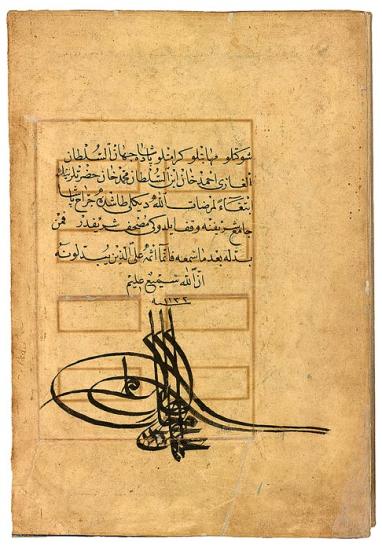
Presentation Page in the Jerrāḥ Pasha Qur˒an
Qur˒an, in Arabic
Purchased by Pierpont Morgan, before 1913
The last page of this Qur˒an contains a lengthy inscription stating that this copy was a pious gift to the holy mosque of Jerrāḥ Pasha in Dikili Tash in Istanbul in the time of "his exalted personage, the imperial, majestic, generous, padishah of the world, the victorious Sultan Aḥmad Khān, son of Sultan Muḥammad Khān, in the year of the Hijra 1131 (1719–20), may God be well pleased [with him]." Beneath the inscription is the magnificent tughra (official signature) of Aḥmad III.
The Qur˒an, the Holy Book of Islam
From a monumental volume used in an Istanbul mosque to a miniature Persian version that served as a talisman, this section features examples of illuminated pages from the holy book of Islam. The Qur˒an (to recite) represents the codification of the words of God that were revealed and transmitted through the angel Gabriel to the prophet Muḥammad (ca. 570–632) over a period of twenty-three years. The visions began in 610 in a cave on Mount Hira near Mecca, his birthplace, and continued after his 622 flight to Medina, until his death. His flight—the Hijra—marks the beginning of the Islamic calendar.
The revelations were arranged into 114 suras (chapters), each named after its theme. The first and shortest ones, at the end of the book, from the Meccan period, establish Muḥammad as the final prophet in a line of monotheists, including Abraham and Jesus. The longest suras, placed at the beginning, are Medinan and deal more with social and political issues.
For centuries, Qur˒ans were written in Arabic, the language of transmission. After Muḥammad's death, his cousin ˓Alī and others compiled the revelations into a text. About twenty years later, under Uthman, the third caliph (644–656) succeeding Muḥammad, a standard version of the Qur˒an —essentially the one used today—was produced. Thereafter Islam (which means "surrender to God") spread from the Arabian Peninsula throughout the Middle East, to northern Africa and southern Spain, and eventually the world.
Miniature Qur˒an and Banner Box
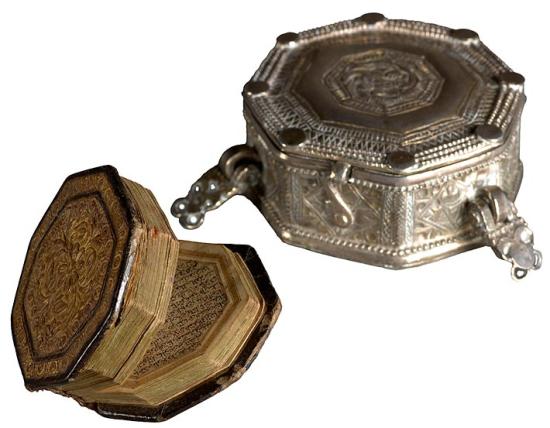
Miniature Qur˒an and Banner Box
Qur˒an, in Arabic
Bequest of Julia Wightman, 1994
Such miniature Qur˒ans are called sancak, after the standard-bearers (sancakdār) who attached them to military flags, where they served as talismans. Travelers also wore them as good-luck charms. This seventeenth-century octagonal example from Persia, which is about an inch and a half tall, is bound on one side and has sixteen lines of text per page. The silver banner box is nineteenth century.
The Qur˒an, the Holy Book of Islam
From a monumental volume used in an Istanbul mosque to a miniature Persian version that served as a talisman, this section features examples of illuminated pages from the holy book of Islam. The Qur˒an (to recite) represents the codification of the words of God that were revealed and transmitted through the angel Gabriel to the prophet Muḥammad (ca. 570–632) over a period of twenty-three years. The visions began in 610 in a cave on Mount Hira near Mecca, his birthplace, and continued after his 622 flight to Medina, until his death. His flight—the Hijra—marks the beginning of the Islamic calendar.
The revelations were arranged into 114 suras (chapters), each named after its theme. The first and shortest ones, at the end of the book, from the Meccan period, establish Muḥammad as the final prophet in a line of monotheists, including Abraham and Jesus. The longest suras, placed at the beginning, are Medinan and deal more with social and political issues.
For centuries, Qur˒ans were written in Arabic, the language of transmission. After Muḥammad's death, his cousin ˓Alī and others compiled the revelations into a text. About twenty years later, under Uthman, the third caliph (644–656) succeeding Muḥammad, a standard version of the Qur˒an —essentially the one used today—was produced. Thereafter Islam (which means "surrender to God") spread from the Arabian Peninsula throughout the Middle East, to northern Africa and southern Spain, and eventually the world.
Early Tenth-Century Qur˒an
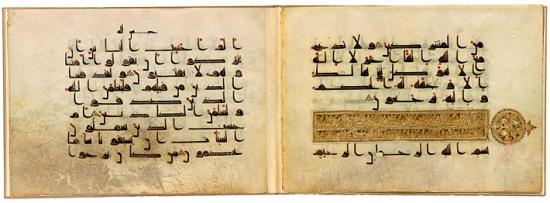
Fragment from an Early Tenth-Century Qur˒an
Qur˒an fragment, in Arabic
Purchased by J. P. Morgan, Jr., 1915
Although the earliest vellum Qur˒ans (late seventh to eighth centuries) were vertical in format, those of the ninth to eleventh centuries were oblong, perhaps inspired by the Kufic script, and featured oblong panels inscribed with Qur˒anic verses. Other folios from this manuscript are preserved in the Chester Beatty Library, Dublin, the Topkapi Palace Museum, Istanbul, and elsewhere, one stating that ˓Abd al-Mun˓im Ibn Aḥmad donated the Qur˒an to the Great Mosque of Damascus during July 911. The Morgan fragment contains suras 27 to 29. Shown here is the heading for sura 29 (al-˓Ankabūt, or "The Spider"), which is written in gold. The name is derived from those who, taking protectors other than Allah, are likened to spiders who build flimsy homes. The diacriticals consist of short diagonal lines, and red dots indicate vocalizations. Pyramids of six gold discs mark the ends of ayat (verses).
The Qur˒an, the Holy Book of Islam
From a monumental volume used in an Istanbul mosque to a miniature Persian version that served as a talisman, this section features examples of illuminated pages from the holy book of Islam. The Qur˒an (to recite) represents the codification of the words of God that were revealed and transmitted through the angel Gabriel to the prophet Muḥammad (ca. 570–632) over a period of twenty-three years. The visions began in 610 in a cave on Mount Hira near Mecca, his birthplace, and continued after his 622 flight to Medina, until his death. His flight—the Hijra—marks the beginning of the Islamic calendar.
The revelations were arranged into 114 suras (chapters), each named after its theme. The first and shortest ones, at the end of the book, from the Meccan period, establish Muḥammad as the final prophet in a line of monotheists, including Abraham and Jesus. The longest suras, placed at the beginning, are Medinan and deal more with social and political issues.
For centuries, Qur˒ans were written in Arabic, the language of transmission. After Muḥammad's death, his cousin ˓Alī and others compiled the revelations into a text. About twenty years later, under Uthman, the third caliph (644–656) succeeding Muḥammad, a standard version of the Qur˒an —essentially the one used today—was produced. Thereafter Islam (which means "surrender to God") spread from the Arabian Peninsula throughout the Middle East, to northern Africa and southern Spain, and eventually the world.
Tenth-Century Qur˒an

Fragment from a Tenth-Century Qur˒an
Qur˒an fragment, in Arabic
Purchased by J. P. Morgan, 1922
Qur˒ans could be in one or multiple volumes, sometimes as many as thirty, in which each volume contained a thirtieth of the text, called a juz˒. The division was especially popular because of the thirty-day holy month of Ramadan, when the entire Qur˒an could be read at the pace of a volume each day. The present fragment, however, was part of a smaller set, as two bands of illumination mark the end of juz˒ 21, which falls at sura 33.31 (al-Aḥzāb, or "The Confederates"). Voweling and diacritics are mostly in red. The gold rosette at the left marks the end of a tenth verse.
The Qur˒an, the Holy Book of Islam
From a monumental volume used in an Istanbul mosque to a miniature Persian version that served as a talisman, this section features examples of illuminated pages from the holy book of Islam. The Qur˒an (to recite) represents the codification of the words of God that were revealed and transmitted through the angel Gabriel to the prophet Muḥammad (ca. 570–632) over a period of twenty-three years. The visions began in 610 in a cave on Mount Hira near Mecca, his birthplace, and continued after his 622 flight to Medina, until his death. His flight—the Hijra—marks the beginning of the Islamic calendar.
The revelations were arranged into 114 suras (chapters), each named after its theme. The first and shortest ones, at the end of the book, from the Meccan period, establish Muḥammad as the final prophet in a line of monotheists, including Abraham and Jesus. The longest suras, placed at the beginning, are Medinan and deal more with social and political issues.
For centuries, Qur˒ans were written in Arabic, the language of transmission. After Muḥammad's death, his cousin ˓Alī and others compiled the revelations into a text. About twenty years later, under Uthman, the third caliph (644–656) succeeding Muḥammad, a standard version of the Qur˒an —essentially the one used today—was produced. Thereafter Islam (which means "surrender to God") spread from the Arabian Peninsula throughout the Middle East, to northern Africa and southern Spain, and eventually the world.
Tenth-Century Qur˒an
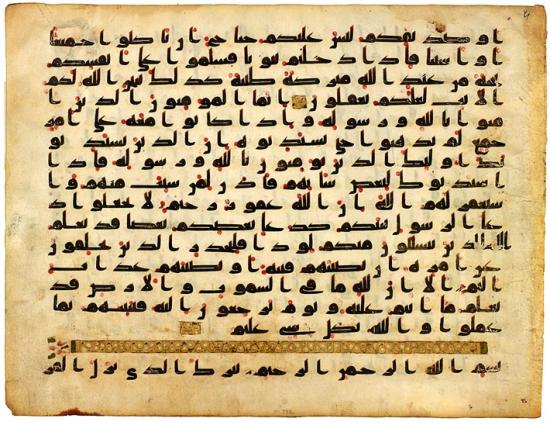
Folio from a Tenth-Century Qur˒an
Qur˒an leaf, in Arabic
Gift of Belle da Costa Greene, 1941
The text is written in Kufic, named after al-Kufah, the Iraqi town where the script supposedly originated. Red dots mark vowels, and each tenth verse is marked by a small, gold rectangle. On this leaf a thin gold band indicates the end of sura 24 (al-Nūr, or "Light") and the beginning of sura 25 (al-Furqān, or "The Criterion"). The Criterion is Allah's great gift to humanity, allowing it to judge between right and wrong. Each sura (except the ninth) begins with a call to piety, the bismillah, In the name of God, the Merciful, the Compassionate.
The Qur˒an, the Holy Book of Islam
From a monumental volume used in an Istanbul mosque to a miniature Persian version that served as a talisman, this section features examples of illuminated pages from the holy book of Islam. The Qur˒an (to recite) represents the codification of the words of God that were revealed and transmitted through the angel Gabriel to the prophet Muḥammad (ca. 570–632) over a period of twenty-three years. The visions began in 610 in a cave on Mount Hira near Mecca, his birthplace, and continued after his 622 flight to Medina, until his death. His flight—the Hijra—marks the beginning of the Islamic calendar.
The revelations were arranged into 114 suras (chapters), each named after its theme. The first and shortest ones, at the end of the book, from the Meccan period, establish Muḥammad as the final prophet in a line of monotheists, including Abraham and Jesus. The longest suras, placed at the beginning, are Medinan and deal more with social and political issues.
For centuries, Qur˒ans were written in Arabic, the language of transmission. After Muḥammad's death, his cousin ˓Alī and others compiled the revelations into a text. About twenty years later, under Uthman, the third caliph (644–656) succeeding Muḥammad, a standard version of the Qur˒an —essentially the one used today—was produced. Thereafter Islam (which means "surrender to God") spread from the Arabian Peninsula throughout the Middle East, to northern Africa and southern Spain, and eventually the world.
Tenth-Century Qur˒an
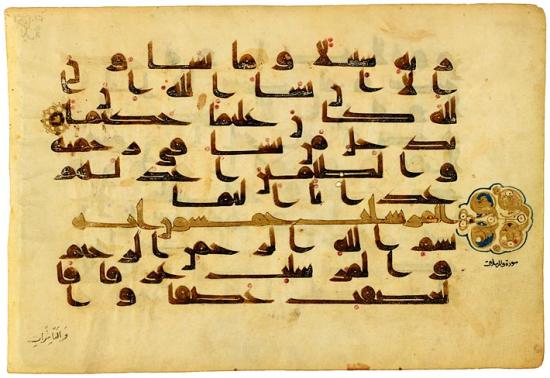
Page from an Oblong Tenth-Century Qur˒an
Qur˒an leaf, in Arabic
Bequest of Belle da Costa Greene, 1950
This is a typical vellum page from an oblong Qur˒an. The script is Kufic, and the red dots indicate vocalization. Every fifth verse is followed by a gold Arabic letter hā˒ (h, which has the numerical value of five; appears on the recto), and every tenth verse by a gold rosette. The heading to sura 77 (al-Mursalāt, or "Those Sent Forth") contains the first line of the sura in gold Kufic script and terminates in a palmette. The name of the sura is written, in cursive script, below the palmette.
The Qur˒an, the Holy Book of Islam
From a monumental volume used in an Istanbul mosque to a miniature Persian version that served as a talisman, this section features examples of illuminated pages from the holy book of Islam. The Qur˒an (to recite) represents the codification of the words of God that were revealed and transmitted through the angel Gabriel to the prophet Muḥammad (ca. 570–632) over a period of twenty-three years. The visions began in 610 in a cave on Mount Hira near Mecca, his birthplace, and continued after his 622 flight to Medina, until his death. His flight—the Hijra—marks the beginning of the Islamic calendar.
The revelations were arranged into 114 suras (chapters), each named after its theme. The first and shortest ones, at the end of the book, from the Meccan period, establish Muḥammad as the final prophet in a line of monotheists, including Abraham and Jesus. The longest suras, placed at the beginning, are Medinan and deal more with social and political issues.
For centuries, Qur˒ans were written in Arabic, the language of transmission. After Muḥammad's death, his cousin ˓Alī and others compiled the revelations into a text. About twenty years later, under Uthman, the third caliph (644–656) succeeding Muḥammad, a standard version of the Qur˒an —essentially the one used today—was produced. Thereafter Islam (which means "surrender to God") spread from the Arabian Peninsula throughout the Middle East, to northern Africa and southern Spain, and eventually the world.
Eleventh-Century Qur˒an
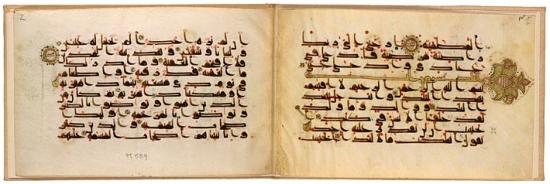
Two Folios from an Eleventh-Century Qur˒an
Qur˒an fragment, in Arabic
Purchased by J. P. Morgan, Jr., 1915
During Muḥammad's lifetime, Islam spread from Mecca and Medina, covering the entire Arabian Peninsula. From there, the new religion expanded throughout the Near East, northern Africa, and southern Spain. Other leaves from this Qur˒an are preserved in the Chester Beatty Library, Dublin, and in the Museum of Turkish and Islamic Art, Istanbul. Written in Kufic, every fifth verse is followed by a gold letter hā˒ (which has a numerical value of five), and every tenth verse by a gold disc with the cumulative number of verses. The color scheme of the palmette projecting from the heading for sura 90 (al-Balad, or "The City"), a combination of wine red and green with gold and blue, is typical for the western Islamic world, suggesting an origin in northern Africa or southern Spain.
The Qur˒an, the Holy Book of Islam
From a monumental volume used in an Istanbul mosque to a miniature Persian version that served as a talisman, this section features examples of illuminated pages from the holy book of Islam. The Qur˒an (to recite) represents the codification of the words of God that were revealed and transmitted through the angel Gabriel to the prophet Muḥammad (ca. 570–632) over a period of twenty-three years. The visions began in 610 in a cave on Mount Hira near Mecca, his birthplace, and continued after his 622 flight to Medina, until his death. His flight—the Hijra—marks the beginning of the Islamic calendar.
The revelations were arranged into 114 suras (chapters), each named after its theme. The first and shortest ones, at the end of the book, from the Meccan period, establish Muḥammad as the final prophet in a line of monotheists, including Abraham and Jesus. The longest suras, placed at the beginning, are Medinan and deal more with social and political issues.
For centuries, Qur˒ans were written in Arabic, the language of transmission. After Muḥammad's death, his cousin ˓Alī and others compiled the revelations into a text. About twenty years later, under Uthman, the third caliph (644–656) succeeding Muḥammad, a standard version of the Qur˒an —essentially the one used today—was produced. Thereafter Islam (which means "surrender to God") spread from the Arabian Peninsula throughout the Middle East, to northern Africa and southern Spain, and eventually the world.
Maghribi Qur˒an
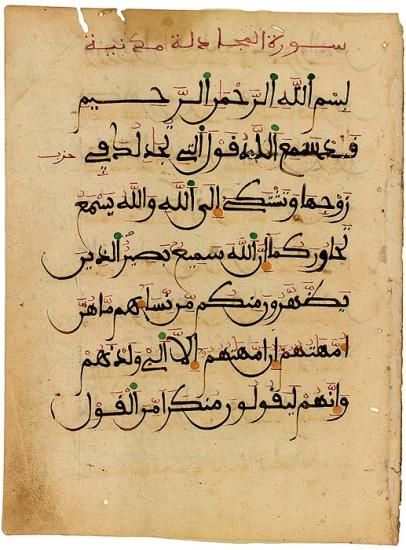
Folio from a Maghribi Qur˒an
Leaf from a Qur˒an, in Arabic
Gift of Mr. and Mrs. Milton Freudenheim in memory of Otto F. Ege, 1985
Qur˒ans produced in the Maghrib (northwestern Africa and Spain) were written in a distinct script—Maghribi—named after the area where it was used. This example, from Morocco, is written in a dark brown ink. Voweling and the sura title are in mauve, yellow dots indicate diacriticals, and green dots appear only above initial alifs (a's). The text is the beginning of sura 58 (al-Mujādila, or "She Who Pleaded"). An early paper example, it is in a vertical format and dates from the twelfth to fourteenth centuries.
The Qur˒an, the Holy Book of Islam
From a monumental volume used in an Istanbul mosque to a miniature Persian version that served as a talisman, this section features examples of illuminated pages from the holy book of Islam. The Qur˒an (to recite) represents the codification of the words of God that were revealed and transmitted through the angel Gabriel to the prophet Muḥammad (ca. 570–632) over a period of twenty-three years. The visions began in 610 in a cave on Mount Hira near Mecca, his birthplace, and continued after his 622 flight to Medina, until his death. His flight—the Hijra—marks the beginning of the Islamic calendar.
The revelations were arranged into 114 suras (chapters), each named after its theme. The first and shortest ones, at the end of the book, from the Meccan period, establish Muḥammad as the final prophet in a line of monotheists, including Abraham and Jesus. The longest suras, placed at the beginning, are Medinan and deal more with social and political issues.
For centuries, Qur˒ans were written in Arabic, the language of transmission. After Muḥammad's death, his cousin ˓Alī and others compiled the revelations into a text. About twenty years later, under Uthman, the third caliph (644–656) succeeding Muḥammad, a standard version of the Qur˒an —essentially the one used today—was produced. Thereafter Islam (which means "surrender to God") spread from the Arabian Peninsula throughout the Middle East, to northern Africa and southern Spain, and eventually the world.
Mamluk Qur˒an
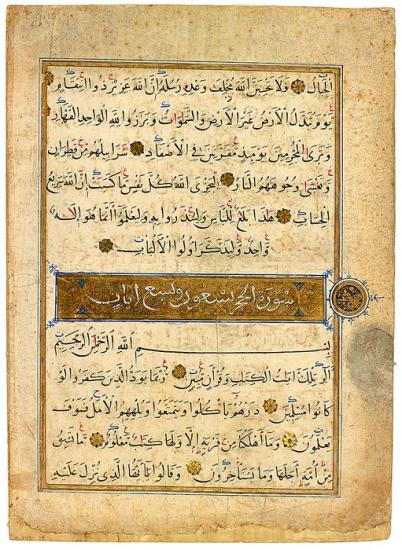
Bifolio from a Mamluk Qur˒an
Bifolio from a Qur˒an, in Arabic
Bequest of Belle da Costa Greene, 1950
With the increased use of paper and the adoption of more upright scripts, the oblong format of the early vellum Qur˒ans gave way to a vertical one. On this page a large heading in white, cursive script marks the beginning of sura 15 (al-Ḥijr, or "The Rocky Tract").The heading is followed by the usual bismillah (call to piety), and the sura text begins on the next line. The sura is in naskh script with vocalizations and diacriticals in black. There are reading marks in red and blue, and rosettes mark the ends of verses.
The Qur˒an, the Holy Book of Islam
From a monumental volume used in an Istanbul mosque to a miniature Persian version that served as a talisman, this section features examples of illuminated pages from the holy book of Islam. The Qur˒an (to recite) represents the codification of the words of God that were revealed and transmitted through the angel Gabriel to the prophet Muḥammad (ca. 570–632) over a period of twenty-three years. The visions began in 610 in a cave on Mount Hira near Mecca, his birthplace, and continued after his 622 flight to Medina, until his death. His flight—the Hijra—marks the beginning of the Islamic calendar.
The revelations were arranged into 114 suras (chapters), each named after its theme. The first and shortest ones, at the end of the book, from the Meccan period, establish Muḥammad as the final prophet in a line of monotheists, including Abraham and Jesus. The longest suras, placed at the beginning, are Medinan and deal more with social and political issues.
For centuries, Qur˒ans were written in Arabic, the language of transmission. After Muḥammad's death, his cousin ˓Alī and others compiled the revelations into a text. About twenty years later, under Uthman, the third caliph (644–656) succeeding Muḥammad, a standard version of the Qur˒an —essentially the one used today—was produced. Thereafter Islam (which means "surrender to God") spread from the Arabian Peninsula throughout the Middle East, to northern Africa and southern Spain, and eventually the world.
Qur˒an Leaf
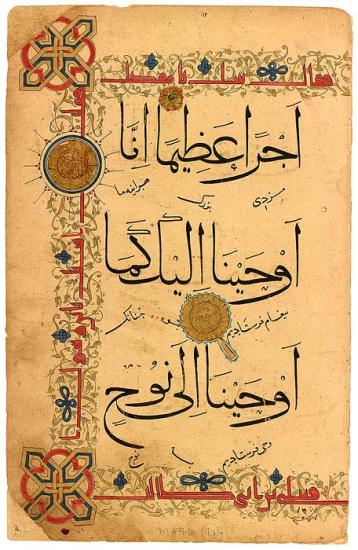
Qur˒an Leaf with Interlinear Persian Translation
Qur˒an leaf, in Arabic and Persian
Bequest of Belle da Costa Greene, 1950
In this unusual leaf, verses 162–63 of sura 4 (al-Nisā˒, or "Woman") are written in a thuluth-muḥaqqaq script, while an interlinear Persian translation, in a small, cursive script, is written diagonally beneath the lines. Of special interest are the red Kufic inscriptions in the border, a Shi˓ite hadith (a saying of Muḥammad), which suggests the danger of independent Qur˒anic interpretation: A question was asked about the son of the Messenger [of God] and ˓Alī Ibn Abī ṭālib said, Woe unto you, O Qatāda, if you interpret the Qur˒an by yourself. The purpose of the central gold medallion is unknown. Other leaves from the manuscript are in the Chester Beatty Library, Dublin, and in the Freer Gallery, Washington, D.C.
The Qur˒an, the Holy Book of Islam
From a monumental volume used in an Istanbul mosque to a miniature Persian version that served as a talisman, this section features examples of illuminated pages from the holy book of Islam. The Qur˒an (to recite) represents the codification of the words of God that were revealed and transmitted through the angel Gabriel to the prophet Muḥammad (ca. 570–632) over a period of twenty-three years. The visions began in 610 in a cave on Mount Hira near Mecca, his birthplace, and continued after his 622 flight to Medina, until his death. His flight—the Hijra—marks the beginning of the Islamic calendar.
The revelations were arranged into 114 suras (chapters), each named after its theme. The first and shortest ones, at the end of the book, from the Meccan period, establish Muḥammad as the final prophet in a line of monotheists, including Abraham and Jesus. The longest suras, placed at the beginning, are Medinan and deal more with social and political issues.
For centuries, Qur˒ans were written in Arabic, the language of transmission. After Muḥammad's death, his cousin ˓Alī and others compiled the revelations into a text. About twenty years later, under Uthman, the third caliph (644–656) succeeding Muḥammad, a standard version of the Qur˒an —essentially the one used today—was produced. Thereafter Islam (which means "surrender to God") spread from the Arabian Peninsula throughout the Middle East, to northern Africa and southern Spain, and eventually the world.
Washing Before Prayer
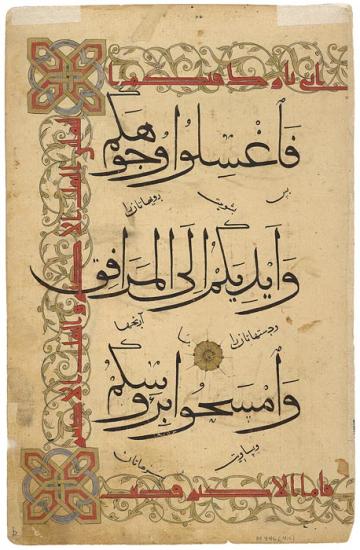
Washing Before Prayer
Qur˒an leaf, in Arabic and Persian
Bequest of Belle da Costa Greene, 1950
Although the Morgan has two leaves from this Qur˒an (see also MS M.846.4a), they are not consecutive, and thus their borders do not match. This page includes verse 6 of sura 5 (al-Mā˒ida, or "The Table"), urging the washing of faces, hands, and arms up to the elbow before praying. The silver Kufic inscription, a Shi˓ite hadith (a saying of Muḥammad), says that the words of ˓Alī and the succeeding imams have the same authority for Shi˓ites as those of the Prophet for Sunni Musliims: "I am going to leave you two valuables, the greater valuable and the lesser valuable. The greater is the book of my god, and the minor is my family and the people of my house [i.e., the twelve Shi˓ite imams]. If you preserve me through them you will never go astray so long as..."
(the text on this page breaks off here).
The Qur˒an, the Holy Book of Islam
From a monumental volume used in an Istanbul mosque to a miniature Persian version that served as a talisman, this section features examples of illuminated pages from the holy book of Islam. The Qur˒an (to recite) represents the codification of the words of God that were revealed and transmitted through the angel Gabriel to the prophet Muḥammad (ca. 570–632) over a period of twenty-three years. The visions began in 610 in a cave on Mount Hira near Mecca, his birthplace, and continued after his 622 flight to Medina, until his death. His flight—the Hijra—marks the beginning of the Islamic calendar.
The revelations were arranged into 114 suras (chapters), each named after its theme. The first and shortest ones, at the end of the book, from the Meccan period, establish Muḥammad as the final prophet in a line of monotheists, including Abraham and Jesus. The longest suras, placed at the beginning, are Medinan and deal more with social and political issues.
For centuries, Qur˒ans were written in Arabic, the language of transmission. After Muḥammad's death, his cousin ˓Alī and others compiled the revelations into a text. About twenty years later, under Uthman, the third caliph (644–656) succeeding Muḥammad, a standard version of the Qur˒an —essentially the one used today—was produced. Thereafter Islam (which means "surrender to God") spread from the Arabian Peninsula throughout the Middle East, to northern Africa and southern Spain, and eventually the world.
Qur˒an from Kashmir
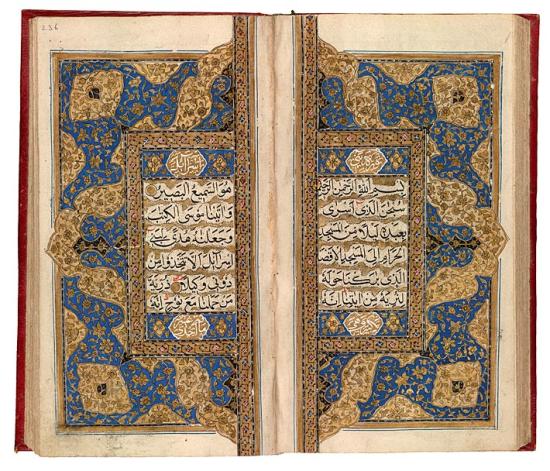
Qur˒an from Kashmir
Qur˒an, in Arabic
Gift of the Trustees of the William S. Glazier Collection, 1984
Qur˒ans were written by hand well into the nineteenth century, and many copies were produced about 1800, when Kashmir was still under Muslim rule. They differ from contemporary Turkish Qur˒ans, which usually provide a date and name of the scribe. The type of decoration found on this double-page sarlauḥ represents typical Kashmiri work of about 1800. This Qur˒an has been divided into sevenths (manzil), one to be read each day of the week, much like the Psalter. Here the double-page sarlauḥ marks the beginning of the fourth division, suras 17 (Bani Isrā-il or "The Israelites") to 25 (al-Furqān or "The Criterion"). The script is naskh, the sura headings are in white, and gold dots follow verses.
The Qur˒an, the Holy Book of Islam
From a monumental volume used in an Istanbul mosque to a miniature Persian version that served as a talisman, this section features examples of illuminated pages from the holy book of Islam. The Qur˒an (to recite) represents the codification of the words of God that were revealed and transmitted through the angel Gabriel to the prophet Muḥammad (ca. 570–632) over a period of twenty-three years. The visions began in 610 in a cave on Mount Hira near Mecca, his birthplace, and continued after his 622 flight to Medina, until his death. His flight—the Hijra—marks the beginning of the Islamic calendar.
The revelations were arranged into 114 suras (chapters), each named after its theme. The first and shortest ones, at the end of the book, from the Meccan period, establish Muḥammad as the final prophet in a line of monotheists, including Abraham and Jesus. The longest suras, placed at the beginning, are Medinan and deal more with social and political issues.
For centuries, Qur˒ans were written in Arabic, the language of transmission. After Muḥammad's death, his cousin ˓Alī and others compiled the revelations into a text. About twenty years later, under Uthman, the third caliph (644–656) succeeding Muḥammad, a standard version of the Qur˒an —essentially the one used today—was produced. Thereafter Islam (which means "surrender to God") spread from the Arabian Peninsula throughout the Middle East, to northern Africa and southern Spain, and eventually the world.
Turkish Qur˒an

Turkish Qur˒an by Pashāzāde
Qur˒an, in Arabic
Purchased by Morgan before 1913; bequest of Belle da Costa Greene, 1950
Unlike late Kashmiri Qur˒ans, those made in Turkey are often fully documented, providing not only a date but the name of the scribe and often that of his teacher. According to the colophon, the manuscript was written in 1832–33 by ˓Alī al-Rusdī al-Asbārtavī, known as Pashāzāde, a student of al-Ḥājj Ḥāfīz Mustafa Ḥelvī, known as Helvajizāde. This sarlauḥ marks the opening of the Qur˒an, with sura 1 (al-Fātiḥa, or "The Opening.") on the right, and sura 2 (al-Baqarah, or "The Heifer") on the left. The text is written in naskh script, and the end of each verse is marked by a rosette. Sura headings, in the cartouches, are written in a white, cursive script.
The Qur˒an, the Holy Book of Islam
From a monumental volume used in an Istanbul mosque to a miniature Persian version that served as a talisman, this section features examples of illuminated pages from the holy book of Islam. The Qur˒an (to recite) represents the codification of the words of God that were revealed and transmitted through the angel Gabriel to the prophet Muḥammad (ca. 570–632) over a period of twenty-three years. The visions began in 610 in a cave on Mount Hira near Mecca, his birthplace, and continued after his 622 flight to Medina, until his death. His flight—the Hijra—marks the beginning of the Islamic calendar.
The revelations were arranged into 114 suras (chapters), each named after its theme. The first and shortest ones, at the end of the book, from the Meccan period, establish Muḥammad as the final prophet in a line of monotheists, including Abraham and Jesus. The longest suras, placed at the beginning, are Medinan and deal more with social and political issues.
For centuries, Qur˒ans were written in Arabic, the language of transmission. After Muḥammad's death, his cousin ˓Alī and others compiled the revelations into a text. About twenty years later, under Uthman, the third caliph (644–656) succeeding Muḥammad, a standard version of the Qur˒an —essentially the one used today—was produced. Thereafter Islam (which means "surrender to God") spread from the Arabian Peninsula throughout the Middle East, to northern Africa and southern Spain, and eventually the world.
Persian Qur˒anic Leaf
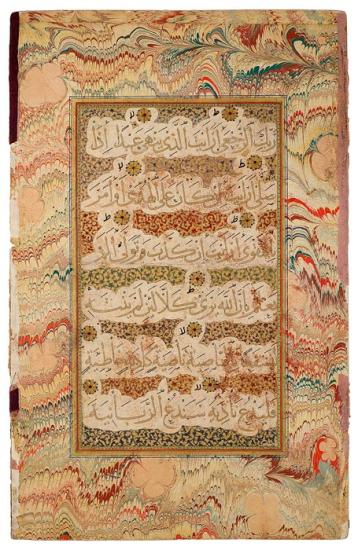
Qur˒anic Leaf from the Read Persian Album
From the Read Persian Album
Purchased by Pierpont Morgan, 1911
Sometimes beautifully written and framed Qur˒anic passages were preserved in albums. This magnificent leaf originally must have faced a page that began with Muḥammad's first revelation (610), sura 96.1—5 (Iqraa, or "Read!" or "Proclaim"), also known as al-˓Alaq ("The Clot of Congealed Blood"), as the present leaf contains verses 8–18. The names come from the verses: Read! (or Proclaim) in the name of your Lord and Cherisher, Who created—created man, out of a [mere] clot of congealed blood. . . .Proclaim . . . He Who taught [the use] of the pen. The six lines of muḥaqqaq script contain ten short ayat (verses), each ending with a gold rosette. Marbling (abri, or "clouds," in Persian) was known in Persia by the sixteenth century, when named abri masters are documented.
The Qur˒an, the Holy Book of Islam
From a monumental volume used in an Istanbul mosque to a miniature Persian version that served as a talisman, this section features examples of illuminated pages from the holy book of Islam. The Qur˒an (to recite) represents the codification of the words of God that were revealed and transmitted through the angel Gabriel to the prophet Muḥammad (ca. 570–632) over a period of twenty-three years. The visions began in 610 in a cave on Mount Hira near Mecca, his birthplace, and continued after his 622 flight to Medina, until his death. His flight—the Hijra—marks the beginning of the Islamic calendar.
The revelations were arranged into 114 suras (chapters), each named after its theme. The first and shortest ones, at the end of the book, from the Meccan period, establish Muḥammad as the final prophet in a line of monotheists, including Abraham and Jesus. The longest suras, placed at the beginning, are Medinan and deal more with social and political issues.
For centuries, Qur˒ans were written in Arabic, the language of transmission. After Muḥammad's death, his cousin ˓Alī and others compiled the revelations into a text. About twenty years later, under Uthman, the third caliph (644–656) succeeding Muḥammad, a standard version of the Qur˒an —essentially the one used today—was produced. Thereafter Islam (which means "surrender to God") spread from the Arabian Peninsula throughout the Middle East, to northern Africa and southern Spain, and eventually the world.